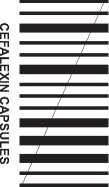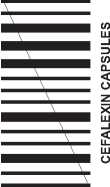Cefalexin 250Mg Capsules

PACKAGE LEAFLET: INFORMATION FOR THE USER Cefalexin Capsules 250mg Cefalexin Capsules 500mg
(cefalexin)
Read all of this leaflet carefully before you start taking this medicine because it contains important information for you.
Keep this leaflet. You may need to read it again.
If you have any further questions, ask your doctor or pharmacist.
This medicine has been prescribed for you only. Do not pass it on to others. It may harm them, even if their signs of illness are the same as yours If you get any side effects, talk to your doctor or pharmacist. This includes any possible side effects not listed in this leaflet. See section 4.
What is in this leaflet:
1. What Cefalexin Capsules are and what they are used for
2. What you need to know before you take Cefalexin Capsules
3. How to take Cefalexin Capsules
4. Possible side effects
5. How to store Cefalexin Capsules
6. Contents of the pack and other information
1. WHAT CEFALEXIN CAPSULES ARE AND WHAT THEY ARE USED FOR
Cefalexin Capsules contain cefalexin as the active ingredient, which belongs to a class of antibiotics called 'cephalosporins'.
Cefalexin Capsules are used to treat following infections caused by bacteria that can be killed by cefalexin:
• Respiratory tract (lung and airways) e.g. tonsillitis, pharyngitis and bronchitis
• Middle ear infections (otitis media)
• Skin and soft tissue (e.g. muscle) infections
• Bone and joint infections
• Infections of the reproductive organs and urinary tract (e.g. cystitis), including acute inflammation of the prostate gland (prostatitis)
• Dental infections.
2. WHAT YOU NEED TO KNOW BEFORE YOU TAKE CEFALEXIN CAPSULES
Do not take Cefalexin Capsules if you:
• Are allergic (hypersensitive) to cefalexin, other cephalosporins (similar antibiotics) or penicillin group of antibiotics, or to any of the ingredients in the product (see Section 6 and end of section 2). An allergic reaction may include rash, itching, difficulty breathing or swelling of the face, lips, throat or tongue.
• Have porphyria; a hereditary metabolic disorder.
Warnings and precautions
Talk to your doctor or pharmacist before taking Cefalexin Capsules if you:
• Have had allergic reaction to cefalexin, cephalosporins, penicillins or other drugs in the past
• Have a severe kidney disorder (you may need reduced dose)
• Develop diarrhoea. This could be symptom of the inflammation of the large intestine. Other symptoms include pain and fever.
Tell your doctor if you are having blood and urine tests. Cefalexin Capsules may interfere with
these tests.
Black

Other medicines and Cefalexin Capsules
Please tell your doctor or pharmacist if you are taking or have recently taken, or might take any other medicines. This includes medicines you buy without a prescription.
In particular, tell your doctor if you are taking any of the following:
• other antibiotics, especially amphotericin, capreomycin, vancomycin, gentamicin or neomycin
• diuretics (water tablets) such as furosemide, bumetanide
• probenecid for a treatment of gout
• metformin for treatment of diabetes
• drugs used to treat leukemia
It may be still be all right for you to be given Cefalexin Capsules and your doctor will be able to decide what is suitable for you.
Cefalexin Capsules with food and drink
These capsules may be taken before, during or after your meals.
Pregnancy and breast-feeding
If you are pregnant or breast-feeding, think you may be pregnant or are planning to have a baby, ask your doctor or pharmacist for advice before taking this medicine.
Driving and using machines
Cefalexin Capsules are not expected to affect your ability to drive or operate machinery. Cefalexin Capsules contains Lactose
Lactose - If you have been told by your doctor that you have an intolerance to some sugars, contact your doctor before taking this medicinal product
3. HOW TO TAKE CEFALEXIN CAPSULES
The doctor will decide on the most appropriate dose for you, based on the nature and severity of your infection. Always take Cefalexin Tablets exactly as your doctor has told you. You should check with your doctor or pharmacist if you are not sure.
Swallow the Capsules whole with water.
Dosage
Adults: The usual total daily dose is 1g to 4g a day, in divided doses.
Most infections can be treated by 500mg every 8 hours. For skin and soft tissue infections, sore throat (Streptococcal pharyngitis), and mild, uncomplicated urinary tract infections, the usual dose is 250mg every 6 hours or 500mg every 12 hours. For more severe infections, larger doses may be needed.
Elderly: You should take the normal adult dose, unless you have severe kidney problems, when the maximum daily dose will be 500mg.
Children over 5 years: Your doctor will calculate the correct dose, depending on the child's weight. The usual daily dose is 25mg to 50mg for each kilogram of their weight, and is usually split up into smaller amounts taken every 8 or 12 hours. For most infections the schedule of 250mg every 8 hours is suggested. In severe infections the dose may be doubled. If your child is taking Cefalexin Capsules for ear infections, he or she may have to take 75mg to 100mg for each kilogram of their weight, split up into smaller doses throughout the day.
This medicine is not recommended for use in children under 5 years of age.
Use all the capsules your doctor has given you. Do not stop taking them, even if you feel better
If you take more Cefalexin Capsules than you should
Contact your doctor or nearest hospital casualty department immediately for advice if you or a child have swallowed too many capsules. Take this leaflet, the pack or any capsules with you, if you can. Symptoms of overdose include nausea, vomiting, stomach upset, appearance of blood in the urine.
If you forget to take Cefalexin Capsules
If you miss a dose, take it as soon as you remember. If it is almost time to take the next dose, skip the missed dose and carry on as before. Do not take a double dose to make up for a forgotten dose.
If you have any further questions on the use of this medicine, ask your doctor or pharmacist.
POSSIBLE SIDE EFFECTS
Like all medicines, Cefalexin Capsules can cause side effects, although not everyone gets them.
Tell your doctor immediately if you get any of these side effects:
• rash
• fever
• itchy skin
• swelling of the lips, eye lids, tongue
• difficulty in breathing, sudden wheeziness.
These are the signs of an allergic reaction. Stop taking the capsules immediately.
Serious side effects
The following side effects are serious. You should stop taking this medicine and contact your doctor immediately if you experience them:
• serious peeling or blistering of the skin
• severe diarrhoea
The following side effects have been reported
• Diarrhoea, stomach pain, heartburn, indigestion
• Lower gut pain, inflammation of colon (colitis), severe diarrhoea containing mucus or blood
• Feeling sick (nausea) or being sick (vomiting)
• Measle like rash
• Itching
• Red wheals on the skin (urticaria)
• Pus in the eyes
• Blisters in the nose or mouth
• Rash with wide spread joint pain and/ or stiffness, swollen lymph glands, fever and, possibly, cloudy urine
• Changes in blood counts, witch may show up as bruising ir a very tired feeling. You will need a blood test to confirm this
• Damage to your liver or kidneys which can be detected by a blood and/ or urine test
• Yellow skin and eye whites (jaunudice)
• Weakness, fainting
• Feeling confused or agitated, seeing or hearing things that are not there (hallucinations), extreme restlessness
• Dizziness, tiredness, headache, sleep disorders, nervousness
• itching around the anus or genitals, inflamed vagina, discharge from the vagina caused by thrush (candidasis)
Reporting of side effects
If you get any side effects, talk to your doctor, pharmacist or nurse. This includes any possible side effects not listed in this leaflet. You can also report side effects directly via the Yellow Card Scheme at: www.mhra.gov.uk/yellowcard
By reporting side effects you can help provide more information on the safety of this medicine.
5. HOW TO STORE CEFALEXIN CAPSULES
Keep this medicine out of the sight and reach of children.
Do not store above 25°C.
Store Cefalexin Capsules in their original package and keep containers tightly closed.
Do not use the capsules after the expiry 'EXP' date which is printed on the carton (the expiry date refers to the last day of the month stated).
Medicines should not be disposed of via wastewater or household waste. Ask your pharmacist how to dispose of medicines no longer required. These measures will help to protect the environment.
6. CONTENTS OF THE PACK AND OTHER INFORMATION
What Cefalexin Capsules contain
The active ingredient is cefalexin, 250mg or 500mg.
The other ingredients are lactose, magnesium stearate. The capsule shell contains black iron oxide (E172), titanium dioxide (E171), erythrosin (E127), quinoline yellow (E104) and gelatin.
What Cefalexin Capsules look like and contents of the pack
Cefalexin Capsules are grey/orange capsule containing white powder and printed with 'CHX 250’ (250mg) or ’CHX 500’ (500mg).
They are available in blisters pack of 7, 14, 20, 21, 28, 30, 50, 56, 60, 100, or 500 capsules (not all pack sizes may be marketed).
Marketing Authorisation Holder
Marketing Authorisation Holder:
Milpharm Limited
Ares, Odyssey Business Park,
West End Road,
South Ruislip HA4 6QD,
United Kingdom.
Manufacturers:
Milpharm Limited
Ares, Odyssey Business Park,
West End Road,
South Ruislip HA4 6QD,
United Kingdom.
APL Swift Services (Malta) Ltd.,
Hf26, Hal Far Industrial Estate,
Hal Far, Birzebbugia, BBG 3000.